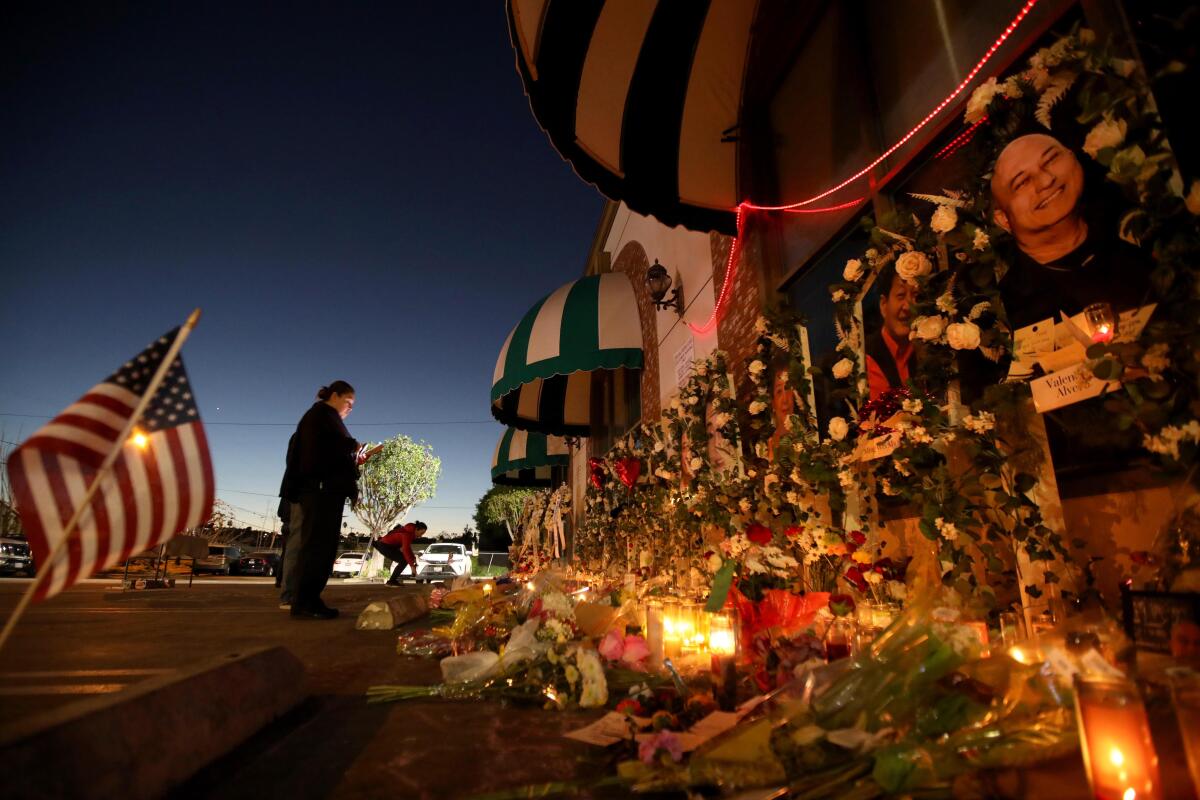Newsletter: Monterey Park. Half Moon Bay. Our deranged gun culture kills again

Good morning. I’m Paul Thornton, and it is Saturday, Jan. 28, 2023. Let’s look back at the week in Opinion.
We’re playing the tape again: A lot of people going about their lives peacefully were killed in an instant because someone arrived on scene with enough anger and strength to squeeze a trigger repeatedly. Of course, I’m talking about the mass shooting Jan. 21 in Monterey Park, where 11 people died at a dance studio amid Lunar New Year revelry. But I could also be talking about Half Moon Bay near San Francisco, where seven farmworkers were gunned down only two days after the Monterey Park shooting. Or I could be talking about Goshen, the Central Valley farming town where six people were killed Jan. 16.
My sincere hope, as it always is when this newsletter must round up reaction to our recurring national nightmare, is that there isn’t some new slaughter that demands our attention by the time you read this. At this point, the commentary writes itself, and all one needs to do is simply list the places and perpetrators of similar massacres to drive the point home that America’s gun worship has set it on a course to national suicide. Which is what The Times’ editorial board did in its piece reacting to Monterey Park:
“Past perpetrators have included the psychotic, domestic abusers, bigots, conspiracy theorists, holders of personal grudges and international terrorists. They are sometimes young, sometimes in their prime, sometimes elderly. They do their cruel, murderous work at dance halls, elementary schools, universities, movie theaters, concerts, grocery stores, houses of worship, parades.
“There is no common profile of the killers, but they have one thing in common: They have guns.”
It’s futile to remain rational and offer deeply researched policy prescriptions for better gun control. We tried earnest policymaking efforts, but the failure of a renewed assault weapons ban and Senate Republicans’ blocking of universal background checks after the 2012 Sandy Hook shooting signaled just how deranged and powerful gun rights groups had become. If 20 murdered first-graders couldn’t move lawmakers a decade ago — and if 19 killed fourth-graders couldn’t do it last year — then 24 dead Californians probably won’t do anything today.
My hope is with the children and teenagers growing up today while watching the adults around them act powerless in the face of such slaughter and terror. Today they protest and beg us to do something; tomorrow, they’ll take action.
This is really stunning: Until this week, the Los Angeles County Probation Department was going ahead with an auction of 337 Smith & Wesson and Beretta handguns with magazines. That ended once a Times editorial writer asked a member of the Board of Supervisors about it, resulting in a motion canceling the sale. The editorial board expressed relief at the outcome, but it still has questions: “How on Earth could the Board of Supervisors be unaware of an auction like this going on under its own nose? And will county officials finally adopt policies that ensure more guns don’t end up on the street?” L.A. Times
Older mass shooters are rare. The Monterey Park suspect was 72 years old, likely the oldest alleged mass shooter in modern history. The Half Moon Bay suspect is 66. Mass shooters have been trending younger, but according to criminologists James Densley and Jillian Peterson, “all perpetrators of mass shootings, young and old, have some things in common. Their mass shooting is intended to be their final act, whether they die by suicide, are killed on scene, or sit and wait to be arrested like the Half Moon Bay suspect did. And, of course, they all have access to the firearms they need to commit these devastating acts.” L.A. Times
Opioids don’t do enough for chronic pain sufferers. The effort to address chronic pain sparked an overdose crisis, demonstrating the need for non-opioid treatments. Many of those treatments have proved more effective than pharmaceuticals, but they remain inaccessible to patients. That must change, writes pain physician and researcher Haider Warraich: “To overcome the opioid epidemic, it is not enough to just reduce how many opioids physicians prescribe. We need to be able to offer patients evidence-based alternatives. Yet for that to happen, we must also better understand the fundamental nature of chronic pain, which is as much an emotion we feel in our minds as it is a physical sensation experienced by our body.” L.A. Times
Enjoying this newsletter? Consider subscribing to the Los Angeles Times
Your support helps us deliver the news that matters most. Become a subscriber.
California wasn’t prepared for the recent atmospheric rivers, partly because we don’t often get such intense precipitation, but also because of the shortcomings of forecasting models. Those models are geared toward predicting the total amount of rain that may fall over a certain period; they often miss the hard-to-predict atmospheric rivers that produce intense storms very quickly. It’s time for an update, writes atmospheric scientist Ned Kleiner: “As climate change affects the atmosphere and weather patterns, all of humanity is now witness to a global science experiment, one that even our best predictions will never fully capture. These recent atmospheric rivers serve as a reminder that models are not infallible and that moving forward our society and infrastructure will be challenged in ways we haven’t yet anticipated.” L.A. Times
Will Mike Pence’s classified documents discovery let President Biden off the hook? Probably not, writes former U.S. attorney Harry Litman, because the appointment of a special counsel each for Biden and former President Trump ties those two very different cases together in the eyes of the public. Still, the Pence revelation points to a big concern: “We do have a serious problem with the retention of classified documents, but it is not a problem the criminal law can or should solve. We need to patch up porous controls, and we need to prosecute individuals who purposefully steal government documents and obstruct all efforts to get them back. From all that we know now, there is only one person in that category.” L.A. Times
Stay in touch.
If you’ve made it this far, you’re the kind of reader who’d benefit from subscribing to our other newsletters and to The Times.
As always, you can share your feedback by emailing me at paul.thornton@latimes.com.
A cure for the common opinion
Get thought-provoking perspectives with our weekly newsletter.
You may occasionally receive promotional content from the Los Angeles Times.




